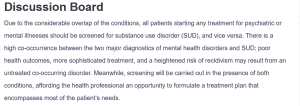Discussion Board
Due to the considerable overlap of the conditions, all patients starting any treatment for psychiatric or mental illnesses should be screened for substance use disorder (SUD), and vice versa. There is a high co-occurrence between the two major diagnostics of mental health disorders and SUD; poor health outcomes, more sophisticated treatment, and a heightened risk of recidivism may result from an untreated co-occurring disorder. Meanwhile, screening will be carried out in the presence of both conditions, affording the health professional an opportunity to formulate a treatment plan that encompasses most of the patient’s needs.
For example, a patient suffering from generalized anxiety disorder (GAD) in conjunction with opioid use disorder (OUD) is of particular interest because of the interrelationship that the two disorders share. Genetic factors may be involved in the arising of the two disorders, predisposing an individual to conditions such as a family history of substance or anxiety abuse. Neural factors also play a role: GAD and OUD are characterized by the dysregulation of the brain’s stress and reward systems. For example, heightened activity of the amygdala and disturbed functioning of the prefrontal cortex regarding reward pathways may contribute to a vulnerability toward both anxiety and addiction, as noted by Volkow et al. (2019). Additionally, environmental factors, such as early exposure to trauma, chronic stress, or socioeconomic challenges, contribute to the development and exacerbation of both conditions.
Notably, in treatment, this patient would be uniformly treated with anxiety, and the substance use disorder would be treated as one. It could include cognitive-behavioural therapy (CBT) specifically for anxiety management, together with medication-assisted treatment for opioid use, such as buprenorphine. In general, both disorders are to be treated together because the superior one gives poor results once the other is treated singly. For example, unless the anxiety is cured, abuse of opioids might continue to undermine improvement in mental health, as indicated by Dydyk et al. (2024). Actually, integrated treatment yields better outcomes for patients. This is because it minimizes the possibility of a relapse, increases the adherence a patient shows toward their therapy, and ensures that the intersecting nature of the disorders is taken care of.
References
Dydyk, A. M., Jain, N. K., & Gupta, M. (2024, January 17). Opioid use disorder. PubMed; StatPearls Publishing. https://www.ncbi.nlm.nih.gov/books/NBK553166/
Volkow, N. D., Michaelides, M., & Baler, R. (2019). The neuroscience of drug reward and addiction. Physiological Reviews, 99(4), 2115–2140. https://doi.org/10.1152/physrev.00014.2018
ORDER A PLAGIARISM-FREE PAPER HERE
We’ll write everything from scratch
Question
- Explain why patients entering treatment for a psychiatric/mental illness should be screened for substance use disorder and vice versa. Provide a clear example (hypothetical) of a substance use disorder and a specific mental health disorder. In your example, explain genetic, neural, and environmental underpinnings for the co-morbid disorder(s). Explain the integrated approach to treatment for this patient and why this is important
Discussion Board


